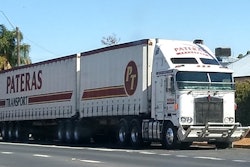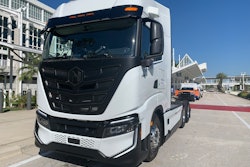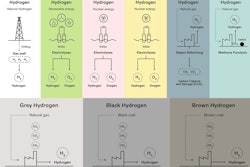
 The back view of an EV charging station at Truck Net truck stop.
The back view of an EV charging station at Truck Net truck stop.
Installed at Truck Net, a full-service truck stop near the U.S./Mexico border, the 250-kilowatt (kW) chargers can provide up to 250 miles per hour of charging for a passenger car, can charge a typical medium-duty box truck from 20% to 80% in about an hour, and fully charge from empty to 100% in about two hours.
[Related: California will be allowed to set its own emissions limits]
"Air pollution doesn't recognize national boundaries, and to accommodate the transition to zero-emission trucks on both sides of the border, it's critically important that we rapidly scale up the charging network," said California Energy Commissioner (CEC) Patty Monahan. "The California Energy Commission is helping fund this project and others across the state to build a better and more equitable charging infrastructure system for both cars and trucks."
The Otay Mesa Port of Entry is the busiest commercial border crossing in California, processing nearly one million commercial trucks and five million privately owned vehicles annually. Idling vehicles waiting to cross the border is a key contributor to air pollution in the San Diego region. While these chargers are designed to provide high power charging for trucks, delivery vans, buses and other large vehicles, they can also be used to charge passenger cars.
"Reducing air pollution and tailpipe emissions are top priorities for our region and California especially in equity priority communities, and SDG&E is committed to building the infrastructure needed to enable businesses and residents to adopt electric vehicles and other clean technologies," said SDG&E CEO Caroline Winn. "We all share the goal of building a cleaner, more sustainable and healthier future."
San Diego County Board of Supervisors Chair Nora Vargas, who represents Otay Mesa and serves on the California Air Resources Board and the County Air Pollution Control District board, in addition to being chair of the San Diego Association of Governments (SANDAG) board, emphasized the importance of reducing emissions in border communities and communities of color that have historically been overburdened by pollution due their proximity to high traffic corridors.
"As a fronteriza and someone who has experienced first-hand the air pollution associated with long lines of idling vehicles waiting to cross the border, I am thrilled to see the electric vehicle chargers installed at this truck stop," said Supervisor Nora Vargas, chair of the San Diego County Board of Supervisors. "This is a true community infrastructure solution that proves that through public-private partnerships, we can improve poor air quality for families and children and promote economic prosperity for the binational region."
The chargers were funded by a $200,000 grant through the CEC's Clean Transportation Program. Now in its 14th year, the program has provided more than $1 billion to alternative fuel and vehicle technology projects that deliver health, environmental, and economic benefits to communities. Funding for the program is scheduled to phase out at the end of the year.
SDG&E built the underlying infrastructure tying the chargers to the grid, as part of its Power Your Drive for Fleets program. The program connects fleet operators with resources and financial incentives to easily and cost-effectively design and install charging infrastructure for medium and heavy-duty fleets.
The project helps support Gov. Gavin Newsom's executive order requiring sales of all new passenger vehicles to be zero-emission by 2035 and medium and heavy-duty vehicles (Class 2b-8) to be zero-emission by 2045 where feasible. According to the CEC, nearly a million battery-electric cars have been sold in California and nearly 2,000 zero-emission trucks and buses are on the road today. The state also has more than 80,000 public and shared private EV chargers. The vast majority, about 90%, are Level 2 chargers, which provide 14-35 miles of range per hour of charging. The remaining 10% are DC fast chargers.












